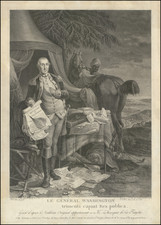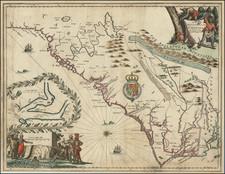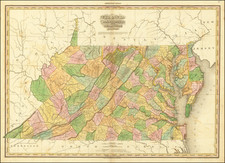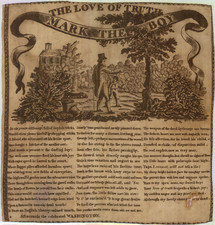Virginia Indians: Their Sitting At Meate
Fine copper plate engraving showing Theodore De Bry's version of John White's painting "Their Sitting At Meate."
The original text in English reads as follows:
Their manner of feeding is in this wise. They lay a mat made of bents on the ground and set their meat on the midst therof, and then sit down Round, the men upon one side, and the women on the other. Their meat is Maize sodden {boiled}, in such sort as I described it in the former treatise of very good taste, deer flesh, or of some other beast, and fish. They are very sober in their eating, and drinking, and consequently very long lived because they do not oppress nature.
In 1585, Governor John White, was part of a voyage from England to the Outer Banks of North Carolina under a plan of Sir Walter Raleigh to settle "Virginia." White was at Roanoke Island for about thirteen months before returning to England for more supplies. During this period he made a series of over seventy watercolor drawings of indigenous people, plants, and animals. The purpose of his drawings was to give those back home an accurate idea of the inhabitants and environment in the New World. The earliest images derived from White's original drawings were made in 1590, when Theodor De Bry made engravings from White's drawings to be printed in Thomas Hariot's account of the journey. Hariot, a mathematician, had also been part of the 1585 voyage.
De Bry's Engravings of the Florida Indians
For his Grands Voyages, De Bry engraved 42 plates based Le Moyne's original sketches made during the French Huguenot voyage to the Florida Peninsula. De Bry's renderings of Florida and its inhabitants are today the earliest known printed European images of Native Americans in present-day Florida, known as the Timucua Indians.
The images attempt to convey a number of messages about the land and its peoples. For example, some of the plates have been suggested to represent the ability of the Timucua to obey authority and that they are less sophisticated than the Europeans. This was argued to make them ideal candidates for French Huegonot colonization, to be used in conflicts against Catholic Spain.
The accuracy of De Bry's depictions have sometimes been called into question. Some of the engravings do not quite match what became known about the Timucua by later French explorers, and some engravings possess out-of-place features, such as the appearance of a Pacific nautilus rather than a Florida whelk shell. However, it is believed that the core of the imagery is correct. For example, the depiction of Timucuan body art, otherwise unknown to Europeans at the time, suggest that De Bry's depictions were grounded in reality.
Theodor de Bry (1528-1598) was a prominent Flemish engraver and publisher best known for his engravings of the New World. Born in Liege, de Bry hailed from the portion of Flanders then controlled by Spain. The de Brys were a family of jewelers and engravers, and young Theodor was trained in those artisanal trades.
As a Lutheran, however, his life and livelihood were threatened when the Spanish Inquisition cracked down on non-Catholics. De Bry was banished and his goods seized in 1570. He fled to Strasbourg, where he studied under the Huguenot engraver Etienne Delaune. He also traveled to Antwerp, London, and Frankfurt, where he settled with his family.
In 1590, de Bry began to publish his Les Grands Voyages, which would eventually stretch to thirty volumes released by de Bry and his two sons. The volumes contained not only important engraved images of the New World, the first many had seen of the geographic novelties, but also several important maps. He also published a collection focused on India Orientalis. Les Grands Voyages was published in German, Latin, French, and English, extending de Bry’s fame and his view of the New World.











![A New Map of Virginia [Chesapeake]](https://storage.googleapis.com/raremaps/img/small/43053.jpg)


